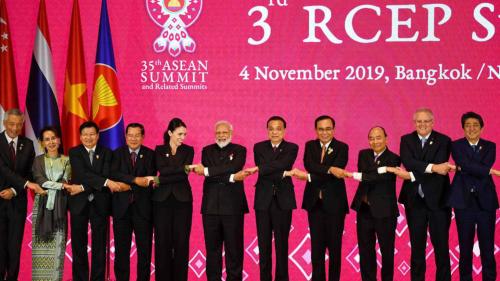China and the RCEP: the new centre of world trade
Western multilateralism, driven by the United States, remains in crisis and shows no signs of recovery. The centre of world trade is in the RCEP countries with the leadership of the Asian Giant.
- Análisis

China will use the Regional Comprehensive Economic Partnership (RCEP) to consolidate its hegemony in the Asia-Pacific. This triumph of regionalism in Asia is a sign of a change in the correlation of forces in the international system; Western multilateralism, driven by the United States, remains in crisis and shows no signs of recovery. The centre of world trade is in the RCEP countries with the leadership of the Asian Giant.
The RCEP treaty came into force in January 2022, is the largest globally and accounts for 30% of global gross domestic product. The ten members of ASEAN, plus China, Japan, South Korea, Australia and New Zealand make up the RCEP. The RCEP standardised the rules that previously governed trade between these countries and will complete the dynamisation of a region that became the centre of gravity of the global economy by 2021.
The Belt and Road Initiative (BRI) is the main instrument through which Beijing projects its interests in the Asia-Pacific. Although the RCEP negotiations took place within ASEAN, China's prominence is undeniable. The RCEP provides a favourable framework for Beijing and the BRI strategic areas: economic cooperation and infrastructure investment.
China is the most important investor in the Asia-Pacific. Chinese investment in Southeast Asia has increased since the announcement of the BRI, from $23 billion (USD) per year in 2012 to $57 billion in 2019. China provides the bulk of foreign direct investment in Brunei, Cambodia and Laos, investing in transport, energy and communications. Between 2019 and 2021, she initiated at least 25 projects linked to the BRI.
The Asian giant increased its energy production from renewable sources and invested in renewable energy in Indonesia, Vietnam, and Thailand but continues to invest in fossil energy in Brunei and the less developed ASEAN countries and Latin America. It is one of the factors why RCEP does not contain environmental considerations.
Source. Investment Report 2020-2021 |
RCEP implies greater integration in countries that account for half of the world's manufacturing, 26% of global value chains (GVCs) and 70% of electronics production. Under these conditions, the centre of international trade shifted from the North Atlantic to Southeast Asia, and intra-RCEP value chains increased by 50% from 2010 to 2020. With the treaty's entry into force, they will grow even more. The region raises its resilience to the externalities of the global economy.
The RCEP dominates telecommunications and electronics production, while Europe has a larger share in pharmaceuticals, automobiles and aerospace. However, Southeast Asia is the initiator of the GVCs discussed here; for example, China's rare earths are indispensable for chip manufacturing critical for aeronautics and automobiles. Some strategic sectors of the world economy depend on Beijing's decisions.
With the RCEP, China's expansion in the Asia-Pacific strengthened while securing the supply of raw materials to nearby countries. Chinese exports will grow thanks to increased construction of connectivity and storage infrastructure. For all states involved, the RCEP provides benefits of trade liberalisation; for China, it means consolidating a regional structure favourable to the BRI.
The vulnerability of the US and the West to China and the RCEP has grown. The Trans-Pacific Partnership (TPP) intended to act as a counterweight to Chinese influence. Still, since Washington's withdrawal, those possibilities were reduced. Conversely, Beijing has established itself as the hegemon of the Asia-Pacific and has applied to join the TPP to become the largest economy in the group.
Source: UNCTAD. Merchandise trade matrix |
The world is going through a period of bipolar multilateralism. The United States faces the breakdown of the post-Cold War unipolar system. The Bretton Woods international financial institutions have lost legitimacy; in their place, China has emerged as the new driver of economic cooperation. The peripheral countries are at a crossroads: continue with US investment or move closer to Beijing. The RCEP is a new driver of economic collaboration and expresses the multilateralism dictated by the Asian giant, despite including US allies like Japan and South Korea.
The RCEP impacts Western-led world trade and worries the US because it consolidates the Asian Giant as a leader on its way to superpower status. The decline in the US leadership of the world economy is observed clearly through the post-pandemic economic crisis and recovery. The historical dependence of the peripheries seems to be shifting from Washington to Beijing rather than diminishing. With the RCEP, the less developed ASEAN countries are on the way to proving this assertion.
Núm. 12, Year 2022, March 18
- Néstor Araujo, Facultad de Estudios Superiores Acatlán, UNAM. Becario de OBELA.
Del mismo autor
Clasificado en
Clasificado en:
Libre Comercio
- José Ramón Cabañas Rodríguez 01/04/2022
- Jorge Murga Armas 31/03/2022
- Jorge Murga Armas 30/03/2022
- Lori Wallach 22/03/2022
- Néstor Araujo 21/03/2022








